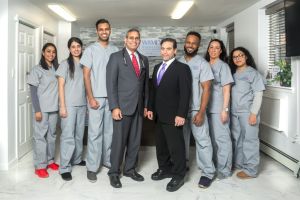Polysomnography
Polysomnography, also known as a sleep study, is a diagnostic test used to evaluate sleep disorders. During a polysomnography, a patient spends a night in a sleep lab while a variety of physiological parameters, such as brain activity, eye movements, heart rate, and breathing patterns, are monitored and recorded. The data collected during a polysomnography can be used to diagnose sleep disorders, determine the severity of sleep problems, and guide treatment decisions.
How does it work?
The test measures various physiological functions during sleep, including brain activity, eye movements, muscle activity, heart rate, respiratory effort, and oxygen saturation. During a polysomnography, a person spends a night in a sleep laboratory or at home with portable equipment. The equipment records the various physiological functions while the person sleeps. The results are then analyzed by a sleep specialist to identify any sleep disorders and determine the appropriate course of treatment.
How is it used?
Polysomnography is typically used to diagnose sleep disorders such as insomnia, sleep apnea, restless leg syndrome, and narcolepsy. It is also used to evaluate the effectiveness of treatment for sleep disorders.
Safety
The test is safe, non-invasive, and well-tolerated by most people. However, some people may experience discomfort from the electrodes or sensors attached to their skin, and some may feel anxious about sleeping in a laboratory or unfamiliar environment.
Home sleep study
With advances in technology, we can now do a mini sleep study at home called home sleep study which is less expensive and is more convenient to the patient.
Summary
Polysomnography is a valuable tool for the diagnosis and treatment of sleep disorders. People with symptoms of a sleep disorder should speak with their healthcare provider about whether a sleep study may be necessary.
References
- American Academy of Sleep Medicine. (2021). Polysomnography. Retrieved from https://aasm.org/resources/patient-information/polysomnography/
- National Sleep Foundation. (2021). Polysomnography. Retrieved from https://www.sleepfoundation.org/polysomnography
- Mayo Clinic. (2021). Polysomnography. Retrieved from https://www.mayoclinic.org/tests-procedures/polysomnogram/about/pac-20395171
- Centers for Disease Control and Prevention. (2021). Sleep Studies. Retrieved from https://www.cdc.gov/sleep/sleep_studies.html
- World Health Organization. (2021). Sleep Disorders. Retrieved from https://www.who.int/news-room/questions-and-answers/item/sleep-disorders
| Sleep medicine navigation. | |
|---|---|
| Sleep disorders | |
| Anatomical | |
| Dyssomnias | |
| Circadian rhythm disorders | |
| Parasomnias | |
| Benign phenomena | |
| Treatment | |
W8MD Weight Loss, Sleep & Medspa Centers
- New York:
- Brooklyn: W8MD's NYC Medical Weight Loss, sleep and medspa 2632 E.21st Street Ste L3, Brooklyn, New York 11235. Call (718) 946 5500
- Pennsylvania
- Philadelphia: Poly-Tech Sleep & W8MD Philadelphia Medical Weight Loss 1718, Welsh Rd, Philadelphia, PA, 19115. Call (215) 676 2334
- King of Prussia: Poly-Tech Sleep & W8MD King of Prussia Medical Weight Loss, Sleep and Medspa 175 Strafford Avenue, Wayne PA 19087 - Executive Commons Ste 1. (215) 676-2334.
- New Jersey
- Cherry Hill: (coming soon) W8MD's New Jersey Weight Loss, Sleep Clinic 140 E Evesham Rd, Cherry Hill, NJ 08003 (215) 676 2334
